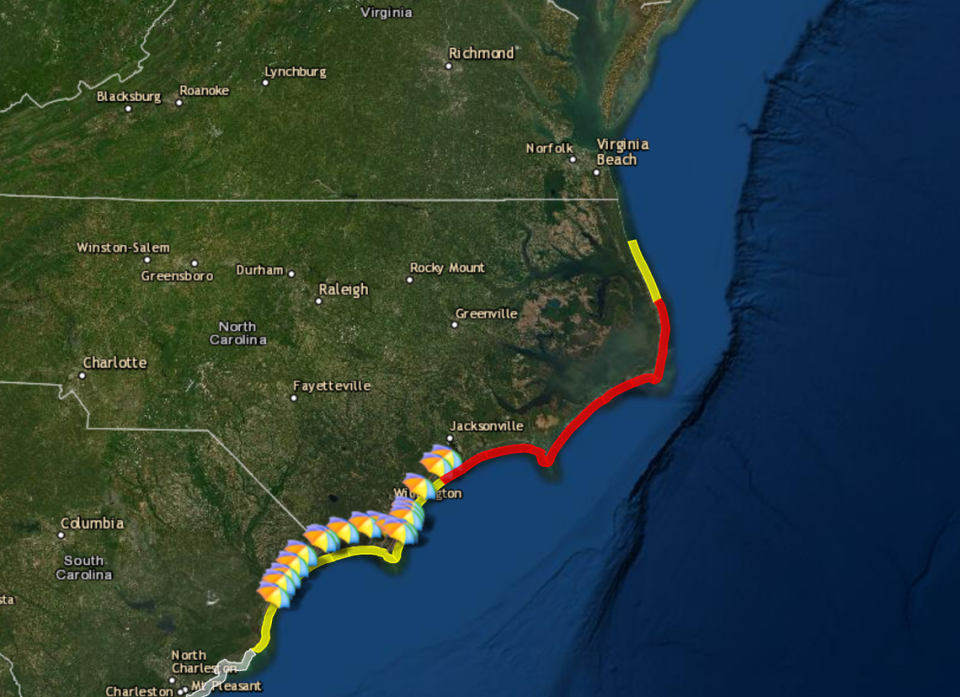Rip currents likely on NC coast after Tropical Storm Colin dissipates, forecasters warn
Dangerous swimming conditions are likely at some North Carolina beaches over the July 4 weekend after Tropical Storm Colin dissipated in the Atlantic, forecasters say.
The storm’s remnants continue to stir up swells that “could cause life-threatening surf and rip current conditions” on the coast through Sunday, July 3, the National Hurricane Center said in its 5 a.m. update. “Gusty winds” on the Outer Banks and “scattered showers and thunderstorms” on parts of the coast were possible through Sunday morning.
Colin formed quickly and unexpectedly off South Carolina overnight Friday, July 1, and into Saturday, July 2, prompting tropical storm warnings along much of the North Carolina coastline. But most of the storm’s winds and rain stayed offshore, The News & Observer reported, and Colin dissipated over Eastern North Carolina.
As of 5 a.m. Sunday, Colin’s remnants were located 10 miles off the coast of New Bern and producing maximum sustained winds of 30 mph, the Hurricane Center said. Tropical storms have wind speeds between 39 and 73 mph.
The remnants were moving northeast at 10 mph.
Rip currents likely at some beaches
As the storm’s remnants pull away from North Carolina, beachgoers are still urged to be cautious.
The National Weather Service’s Wilmington Office, which covers southeastern North Carolina, tweeted that an “increased risk of strong rip currents continue Sunday for local beaches.” A high rip current risk remains in effect until 8 p.m. in coastal Pender and New Hanover Counties.
The NWS’s Newport/Morehead Office, which covers Eastern North Carolina, including parts of the state’s Outer Banks, tweeted that there is a high rip current risk Sunday, especially south of the Oregon Inlet. Much of the coastline is under a hazardous weather outlook.
“If heading to the beach listen to the advice of the beach patrol,” the office wrote.
The NWS’s beach forecast shows a high risk of rip currents between Pender County and part of Dare County as of Sunday morning. Other parts of the coast are under a moderate risk.

A high risk of rip currents indicates “life-threatening rip currents are likely in the surf zone” and that “the surf is dangerous for all levels of swimmers,” the NWS said.
A moderate risk means “life-threatening rip currents are possible in the surf zone.” Beachgoers are urged to swim near a lifeguard and “heed the advice of the local beach patrol and flag warning systems.”
Rip current safety
Rip currents are “channelized currents of water flowing away from shore,” according to the NWS.
“Rip current speeds vary,” the NWS said. “Average speeds are 1-2 feet per second, but they have been measured as fast as 8 feet per second — faster than an Olympic swimmer!”
They can pull swimmers away from shore but will not pull them under the water.
If caught in a rip current, do not try to swim against it, the NWS said.
Instead, stay calm and try to swim parallel to the shore until you are out of the rip current, then “follow breaking waves back to shore at an angle,” the National Oceanic and Atmospheric Administration said.
“You may be able to escape by floating or treading water if the current circulates back toward shore,” officials said. “If you feel you will be unable to reach shore, draw attention to yourself. If you need help, yell and wave for assistance.”
If you see someone caught in a rip current, get help from a lifeguard or call 911, direct the swimmer to follow the shoreline to escape the current and throw them a flotation device if possible, the NWS said. But don’t enter the water without a flotation device, the NWS said, as “many people have died trying to rescue rip current victims.”
Outer Banks tourists pull struggling swimmer from ocean only to see him die on beach
Bystanders ‘risked their lives’ trying to save drowning woman at NC beach, officials say
Rip currents sweep three children out to sea from beach, New Jersey rescuers say
Powerful rip current sweeps two to sea at popular SC beach — and then rescuers step in

